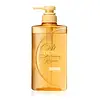What's inside
What's inside
 Key Ingredients
Key Ingredients

 Benefits
Benefits

 Concerns
Concerns

 Ingredients Side-by-side
Ingredients Side-by-side

Water
Skin ConditioningDisodium Laureth Sulfosuccinate
CleansingCoco-Betaine
CleansingDisodium Lauryl Sulfosuccinate
CleansingDisodium Cocoamphodiacetate
CleansingLauryl Glucoside
CleansingSodium Chloride
MaskingDisodium Cocoyl Glutamate
CleansingNiacinamide
SmoothingPanthenol
Skin ConditioningSalicylic Acid
MaskingCapryloyl Salicylic Acid
ExfoliatingGluconolactone
Skin ConditioningSea Water
HumectantEnteromorpha Compressa Extract
Skin ProtectingSalicornia Herbacea Extract
Skin ConditioningClay Extract
Skin ConditioningSpirulina Platensis Extract
Skin ProtectingCentella Asiatica Extract
CleansingMadecassoside
AntioxidantAsiaticoside
AntioxidantAsiatic Acid
Skin ConditioningGlycoproteins
Skin ConditioningHydrolyzed Keratin
HumectantHydrolyzed Soy Protein
HumectantHydrolyzed Oat Protein
Skin ConditioningHydrolyzed Rice Protein
Skin ConditioningArginine
MaskingCysteine
AntioxidantGlycine
BufferingLysine
Skin ConditioningSerine
MaskingCaesalpinia Spinosa Fruit Extract
Skin ProtectingHelianthus Annuus Sprout Extract
Skin ConditioningPolyquaternium-22
Citric Acid
BufferingMenthol
MaskingPhenethyl Alcohol
MaskingTrihydroxystearin
Skin ConditioningCaprylyl Glycol
EmollientMenthyl Lactate
MaskingSodium Phytate
Hexylene Glycol
EmulsifyingEthylhexylglycerin
Skin Conditioning1,2-Hexanediol
Skin ConditioningMaltodextrin
AbsorbentParfum
MaskingWater, Disodium Laureth Sulfosuccinate, Coco-Betaine, Disodium Lauryl Sulfosuccinate, Disodium Cocoamphodiacetate, Lauryl Glucoside, Sodium Chloride, Disodium Cocoyl Glutamate, Niacinamide, Panthenol, Salicylic Acid, Capryloyl Salicylic Acid, Gluconolactone, Sea Water, Enteromorpha Compressa Extract, Salicornia Herbacea Extract, Clay Extract, Spirulina Platensis Extract, Centella Asiatica Extract, Madecassoside, Asiaticoside, Asiatic Acid, Glycoproteins, Hydrolyzed Keratin, Hydrolyzed Soy Protein, Hydrolyzed Oat Protein, Hydrolyzed Rice Protein, Arginine, Cysteine, Glycine, Lysine, Serine, Caesalpinia Spinosa Fruit Extract, Helianthus Annuus Sprout Extract, Polyquaternium-22, Citric Acid, Menthol, Phenethyl Alcohol, Trihydroxystearin, Caprylyl Glycol, Menthyl Lactate, Sodium Phytate, Hexylene Glycol, Ethylhexylglycerin, 1,2-Hexanediol, Maltodextrin, Parfum
Water
Skin ConditioningIsopentyldiol
HumectantStearyl Alcohol
EmollientBehentrimonium Chloride
PreservativeGlycerin
HumectantDimethicone
EmollientCetearyl Alcohol
EmollientBehenyl Alcohol
EmollientAminopropyl Dimethicone
Hydrogenated Polyisobutene
EmollientSteartrimonium Chloride
PreservativePolysilicone-13
Camellia Seed Oil
Lactic Acid
BufferingLysine Lauroyl Glutamate
CleansingSqualane
EmollientRoyal Jelly Extract
Skin ConditioningGlycine Max Seed Extract
Skin ConditioningIsopropyl Alcohol
SolventDipropylene Glycol
HumectantIsopropyl Myristate
EmollientPEG-2 Laurate
EmulsifyingSalicylic Acid
MaskingAmodimethicone
PPG-2-Deceth-12
EmulsifyingMethylserine
Skin ConditioningDisodium EDTA
Cetrimonium Chloride
AntimicrobialButylene Glycol
HumectantTocopherol
AntioxidantSodium Benzoate
MaskingPhenoxyethanol
PreservativeParfum
MaskingCI 17200
Cosmetic ColorantCI 15985
Cosmetic ColorantWater, Isopentyldiol, Stearyl Alcohol, Behentrimonium Chloride, Glycerin, Dimethicone, Cetearyl Alcohol, Behenyl Alcohol, Aminopropyl Dimethicone, Hydrogenated Polyisobutene, Steartrimonium Chloride, Polysilicone-13, Camellia Seed Oil, Lactic Acid, Lysine Lauroyl Glutamate, Squalane, Royal Jelly Extract, Glycine Max Seed Extract, Isopropyl Alcohol, Dipropylene Glycol, Isopropyl Myristate, PEG-2 Laurate, Salicylic Acid, Amodimethicone, PPG-2-Deceth-12, Methylserine, Disodium EDTA, Cetrimonium Chloride, Butylene Glycol, Tocopherol, Sodium Benzoate, Phenoxyethanol, Parfum, CI 17200, CI 15985
 Reviews
Reviews

Ingredients Explained
These ingredients are found in both products.
Ingredients higher up in an ingredient list are typically present in a larger amount.
Parfum is a catch-all term for an ingredient or more that is used to give a scent to products.
Also called "fragrance", this ingredient can be a blend of hundreds of chemicals or plant oils. This means every product with "fragrance" or "parfum" in the ingredients list is a different mixture.
For instance, Habanolide is a proprietary trade name for a specific aroma chemical. When used as a fragrance ingredient in cosmetics, most aroma chemicals fall under the broad labeling category of “FRAGRANCE” or “PARFUM” according to EU and US regulations.
The term 'parfum' or 'fragrance' is not regulated in many countries. In many cases, it is up to the brand to define this term.
For instance, many brands choose to label themselves as "fragrance-free" because they are not using synthetic fragrances. However, their products may still contain ingredients such as essential oils that are considered a fragrance by INCI standards.
One example is Calendula flower extract. Calendula is an essential oil that still imparts a scent or 'fragrance'.
Depending on the blend, the ingredients in the mixture can cause allergies and sensitivities on the skin. Some ingredients that are known EU allergens include linalool and citronellol.
Parfum can also be used to mask or cover an unpleasant scent.
The bottom line is: not all fragrances/parfum/ingredients are created equally. If you are worried about fragrances, we recommend taking a closer look at an ingredient. And of course, we always recommend speaking with a professional.
Learn more about ParfumSalicylic Acid (also known as beta hydroxy acid or BHA) is a well-known ingredient for treating skin that struggles with acne and clogged pores. It exfoliates both the skin's surface and deep within the pores to help clear out buildup, control oil, and reduce inflammation.
Unlike AHAs (alpha hydroxy acids), salicylic acid is oil-soluble. This allows it to penetrate into pores which makes it especially effective for treating blackheads and preventing future breakouts.
Salicylic acid is also known for its soothing properties. It has a similar structure to aspirin and can calm inflamed or irritated skin, making it a good option for acne-prone skin that is also sensitive.
Concentrations of 0.5-2% are recognized by the U.S. FDA as an over-the-counter topical acne product.
It can cause irritation and/or dryness if one's skin already has a compromised moisture barrier, so it's best to focus on repairing that before introducing this ingredient into your routine.
While salicylic acid does not increase sun sensitivity, it’s still important to wear sunscreen daily to protect your skin.
If you are looking for the ingredient called BHA or Butylated Hydroxyanisole, click here.
Learn more about Salicylic AcidWater. It's the most common cosmetic ingredient of all. You'll usually see it at the top of ingredient lists, meaning that it makes up the largest part of the product.
So why is it so popular? Water most often acts as a solvent - this means that it helps dissolve other ingredients into the formulation.
You'll also recognize water as that liquid we all need to stay alive. If you see this, drink a glass of water. Stay hydrated!
Learn more about Water